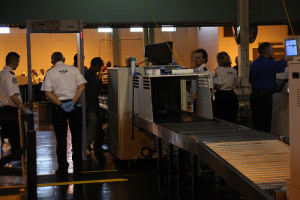 A new X-ray scanner that uses 3D-imaging and can identify precisely what material an object is made of, is being developed for use in airport security. The technology could revolutionize airport security by making it easier to spot weapons and explosives inside bags. The new X-ray scanning technology could eliminate physical bag searches and speed up screening.
A new X-ray scanner that uses 3D-imaging and can identify precisely what material an object is made of, is being developed for use in airport security. The technology could revolutionize airport security by making it easier to spot weapons and explosives inside bags. The new X-ray scanning technology could eliminate physical bag searches and speed up screening.
The scanner is being developed by a team of scientists from Nottingham Trent University and the Cranfield Forensic Institute at Cranfield University. The Halo technology uses funnel-shaped X-rays to build the image and it can process an object’s “material signature” to determine what it’s made of an detect the presence of bombs or other illicit materials in milliseconds.
The Halo scanner uses the principles of X-ray crystallography, which is a technique that analyzes how a particular material scatters X-ray particles when they hit it and then its composition could be determined. The typical way each material interacts with radiations works as a “material signature.” Then the 3D reconstruction of the scattering patterns would be analyzed by the machine’s software and matched against a library of thousands of “material signatures”, in order to make the determination of what materials are made of. The whole process would take milliseconds, and the technology is also made to be fully automated, meaning that no humans would be needed to monitor the images. Halo will create an alert if dangerous materials are detected.
Current scanners at airports are only able to distinguish between metal, plastic and organic items. The new Halo technology promises to reveal exactly what is in each bag
Besides accuracy and efficiency, the new scanner offers lower cost as well. Along with security purposes, it could be used in other fields, like health or engineering.
